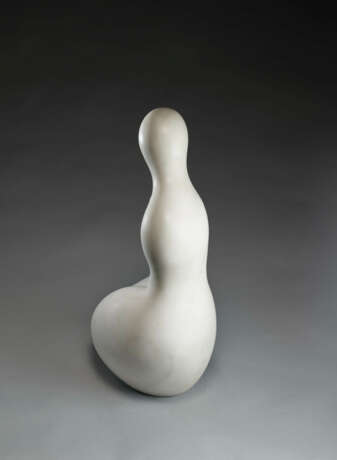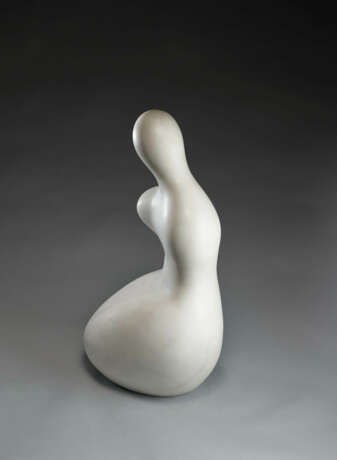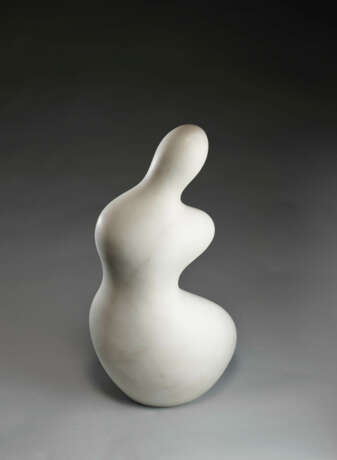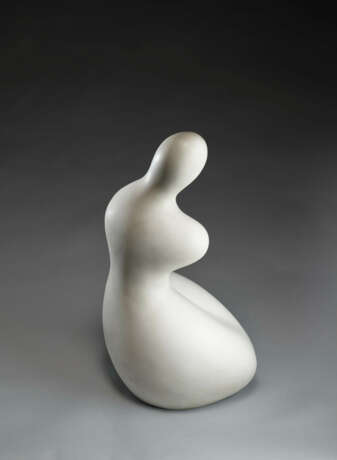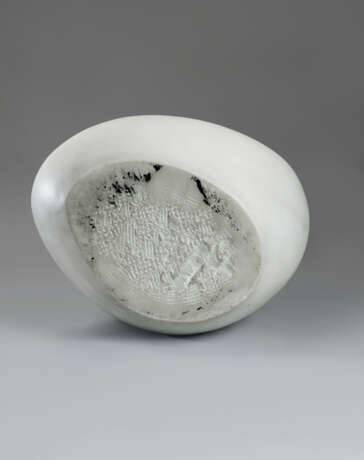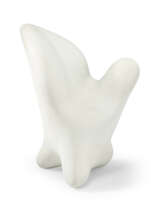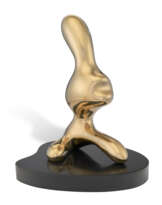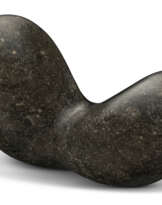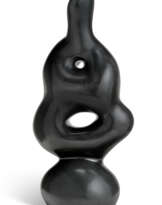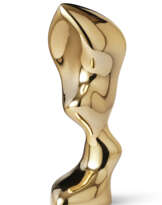ID 832062
Лот 33 | Jean (Hans) Arp (1886-1966)
Оценочная стоимость
€ 1 800 000 – 2 500 000
Déméter
marbre blanc
Hauteur: 65.5 cm.
Conçu et exécuté en 1960; cette œuvre est unique
white marble
Height: 25 3/4 in.
Conceived and executed in 1960; this work is unique
Provenance
Pierre Loeb, Paris (avant 1964).
Isidoro Cohn, New York.
Weintraub Gallery, New York.
Vente, Sotheby Parke Bernet, Inc., New York, 19 octobre 1977, lot 53.
Sidney Janis Gallery, New York (acquis au cours de cette vente).
Robert Miller Gallery, New York.
Acquis auprès de celle-ci par le propriétaire actuel en 1981.
Literature
E. Trier, Jean Arp, Sculptures, 1957-1966, Stuttgart, 1968, p. 113, no. 212 (illustré, p. 152).
I. Jianou, Jean Arp, Paris, 1973, p. 77, no. 212 (la grande version en marbre illustrée, pl. 39).
A. Hartog et K. Fischer, éds., Hans Arp, Sculptures, A Critical Survey, Ostfildern, 2012, p. 331, no. 212 (la version en bronze illustrée).
Exhibited
Genève, Galerie Du Perron, Hommage a' Jean-Hans Arp, juin-septembre 1962, no. 9 (illustré).
Special notice
ƒ: In addition to the regular Buyer’s premium, a commission of 5.5%
inclusive of VAT of the hammer price will be charged to the buyer.
It will be refunded to the Buyer upon proof of export of the lot
outside the European Union within the legal time limit.
(Please refer to section VAT refunds)
Post lot text
S'il a principalement produit des reliefs pendant ses années Dada et surréalistes, à partir de 1930, Arp est de plus en plus attiré par les volumes expansifs et dilatés de la sculpture en ronde-bosse. Transformant les surfaces planes de ses premiers bois découpés « biomorphiques » en véritables créations sculpturales en trois dimensions, Arp formule dès lors un vocabulaire de formes bourgeonnantes, organiques qui irriguera son art durant les trente années suivantes. Aussi fonde-t-il l'ensemble de son expression sur des principes de métamorphose constante, en écho aux lois essentielles de régénérescence et d'évolution de la nature elle-même, n'hésitant pas à remanier ses motifs pour les refondre et les muer en de nouvelles masses amorphes qui évoquent tant le corps humain que la matière minérale ou végétale.
Dans cette sculpture, Arp interprète le phénomène de l'expansion et du renouveau perpétuels à travers la figure nourricière de Déméter, mère dévouée de Perséphone et déesse de l'agriculture, qui orchestrait le cycle des saisons dans la mythologie grecque. « Et Déméter couronnée […], peut-on lire dans L'Hymne homérique à Déméter, fit aussitôt des labours féconds lever le grain ; tout entière la vaste terre se chargea de feuilles et de fleurs » (vers 470-473 ; trad. Jean Humbert). Après son second voyage en Grèce en 1955, Arp incorpore régulièrement des motifs classiques comme celui-ci – distillés et simplifiés – dans son langage sculptural. Ici, c'est tout en volumes bulbeux et voluptueux qu'il donne corps à sa Déméter assise, dont le giron semble être le siège d'une nature intrinsèquement maternelle ; les hanches généreuses viennent évoquer la fécondité tandis que la tête s'incline dans une attitude protectrice. Selon une tout autre lecture, on pourrait aussi percevoir cette sculpture comme le germe d'une plante, dont les pousses prendraient leur essor dans la fente d'une graine.
Arp a sans doute également puisé son inspiration pour cette Déméter auprès de la statuaire du Proche-Orient qu'il découvre en 1960 lors d'une expédition en Égypte, en Jordanie et en Israël, au cœur du Croissant fertile qui vit naître l'agriculture et les premières civilisations. Avec leur poitrine, leur ventre et leurs cuisses aux proportions démesurées, les « statuettes de fertilité » antiques de la région (des figurines féminines diversement interprétées comme des offrandes votives, des objets rituels ou des représentations de déesses) incarnaient pleinement le rapport primaire entre la maternité humaine et la fécondité de la Terre – sujet qu'Arp réinterprète à son tour dans la présente sculpture.
Cette version de Déméter – d'une hauteur de 65,4 cm – est fidèle au format de l'œuvre originelle conçue par Arp en 1960. L'année suivante, le sculpteur en réalisa un agrandissement de 100,3 cm, dont l'unique exemplaire en marbre, autrefois abrité par la collection Herbert et Adele Klapper, a été vendu à Christie's New York en novembre 2018 pour plus de 5,8 millions de dollars (multipliant presque par trois son estimation basse initiale). Il n'existerait qu'un seul marbre de la « petite Déméter » (le présent lot) , ainsi que cinq bronzes et une épreuve en plâtre (actuellement entre les murs du Musée d’art moderne de Strasbourg). Le format plus imposant a par ailleurs été décliné en trois bronzes et un plâtre (conservé au Detroit Institute of Arts), chaque matériau créant un effet expressif distinct et révélant l'œuvre sous un jour différent. Extrait de la terre avant d'être poli pour obtenir une surface lisse, d'une luminosité subtile, le marbre blanc qu'Arp a choisi pour la présente Déméter accentue notamment l'impression de pureté primaire, minérale, absolue, que dégagent ces formes inspirées du monde naturel.
After devoting himself principally to relief sculpture throughout his Dada and Surrealist years, Arp found himself by 1930 increasingly drawn to the expanded volumes of sculpture in the round. Transforming the flat, biomorphic shapes of his earlier reliefs into fully fledged, standing sculptural creations, Arp arrived at a language of burgeoning, organic forms that served as the wellspring of his art for the remaining three decades of his career. He rooted his creative activity in principles of ceaseless metamorphosis that echo the generative and evolutionary processes of nature itself, continually recasting his elemental motifs into new, vital forms that suggest both human and vegetal affinities.
In the present sculpture, Arp interpreted the theme of growth and renewal through the trope of the classical Greek earth-mother Demeter, goddess of agriculture, who governed the cycle of the seasons. “She with the beautiful garlands in her hair,” reads the Homeric Hymn to Demeter, “sent up the harvest from the land with its rich clods of earth. And all the wide earth with leaves and blossoms was laden” (lines 470-473; trans. Gregory Nagy). Ever since his second trip to Greece in 1955, Arp had frequently incorporated classical motifs—distilled and abstracted—into his sculptural language. Here, Arp conceived the seated figure of Demeter, devoted mother of Persephone, in sensuous, swelling volumes. Her lap is a site of maternal nurturing; the wide hips evoke abundant fertility, while the tilted head suggests protective care. At the same time, the sculpture may be read as a germinating plant, with new growth unfurling upward from the cleft in the seed.
Additional inspiration for Déméter may have come during a trip that Arp took in 1960 to Egypt, Jordan, and Israel—part of the Fertile Crescent, where agriculture first flourished and the earliest human civilizations hence took root. Ancient female “fertility figurines” from the region—variously interpreted as votive offerings, ritual objects, or representations of goddesses—exaggerate the breasts, belly, and thighs of the subject, embodying an essential, primordial connection between human motherhood and the earth’s fecundity that Arp revived in the present sculpture.
This version of Déméter - with a height of 25 ¾ inches (65.4 cm.) – is the original size that Arp conceived in 1960. The following year, Arp made a 39 ½ inch (100.3 cm.) enlargement, of which the sole example in marble, previously in the Herbert and Adele Klapper collection, was sold at Christie’s New York in November 2018 for more than 5.8 M USD (almost three times its pre-sale low estimate). The smaller version of the figure is known in a single marble – the present lot -, an edition of five bronze casts, and a plaster model (housed at the Musée d’Art Moderne, Strasbourg). Meanwhile, the larger version exists in three bronzes and a plaster (preserved at the Detroit Institute of Arts), with each material creating a different expressive effect. Polished to a smooth and subtly luminous surface, the white marble—quarried from the earth—that Arp selected for the present Déméter highlights the elemental purity of the forms and emphasizes their origin in the natural world.
| Автор: | Жан Арп (1886 - 1966) |
|---|---|
| Материал: | Мрамор, Камень |
| Автор: | Жан Арп (1886 - 1966) |
|---|---|
| Материал: | Мрамор, Камень |
| Адрес торгов |
CHRISTIE'S 8 King Street, St. James's SW1Y 6QT London Великобритания | |
|---|---|---|
| Предосмотр |
| |
| Телефон | +44 (0)20 7839 9060 | |
| Комиссия | see on Website | |
| Условия использования | Условия использования |

